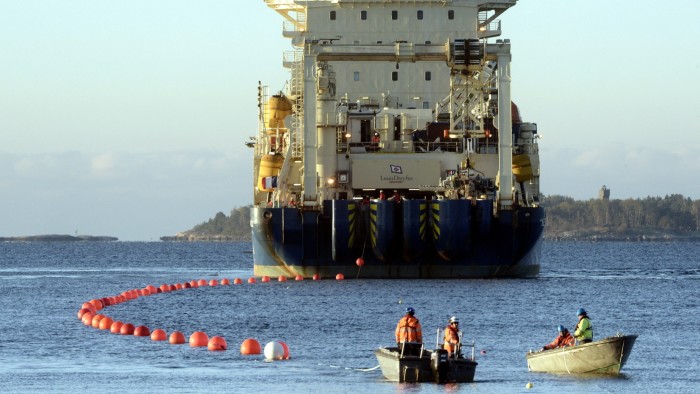Unlock the Editor’s Digest for free
Roula Khalaf, Editor of the FT, selects her favourite stories in this weekly newsletter.
Japan’s subsea cable champion NEC is set to receive government support to buy the ships needed to put it on a par with US, French and Chinese rivals, as the vital communications infrastructure increasingly becomes a national security concern.
NEC charters its vessels, while the other three major global players — New Jersey-based SubCom, France’s state-owned Alcatel Submarine Networks, and China’s HMN Tech, a former Huawei subsidiary — all have the advantage of owning cable-laying fleets.
Officials in Tokyo are preparing to close that gap by providing subsidies that could be worth hundreds of millions of dollars for NEC to buy ships. It currently relies on a subsea cable-laying vessel leased from a Norwegian group in 2022 on a four-year charter, partnerships with other companies and on renting the specialist ships on an ad hoc basis to meet surging demand for fibre-optic cabling in the Indo-Pacific.
NEC dominates installations in Asia and has laid more than 400,000km of cables globally. It also specialises in armoured cables that can better withstand sabotage.
Globally, there are 63 cable-laying ships, according to the International Cable Protection Committee. France’s ASN owns seven, while SubCom and HMN Tech are believed to own seven and two, respectively, but did not reply to requests for confirmation.
Japanese telecoms groups NTT and KDDI own cable-laying vessels, which are rented out to NEC, but they are not the larger kind of vessels required to lay transocean cables.
Two Japanese government officials said Tokyo viewed NEC’s lack of ships and weakened competitive position as a national security issue.
The state could pay up to half towards acquiring multiple vessels that cost about $300mn each, as soon as early 2027, but no decision has been made yet, and finance ministry approval would be required.
A shortage of ships is one of the major bottlenecks to achieving the 26 per cent rise per year predicted for global data transmission to 2031, driven by video streaming and artificial intelligence services led by big tech groups such as Meta and Google, according to the TeleGeography telecoms data service.
Without its own vessels, NEC risks losing Big Tech contracts because of its inability to guarantee that the work can be done as quickly as its competitors, one official said.
“The Japanese government thinks this situation is very serious, so we are thinking we need to make some intervention,” the official added.
Another Japanese official cited the threats of espionage or cable-cutting sabotage, as well as the future military use of submarine cables as sensors to detect submarines, as reasons behind the potential support.
Up to 200 cables are damaged annually, primarily due to fishing or anchors, but also through sabotage, as seen in the disruption caused to two cables in the Baltic Sea last year.
Chartering for an accurate period has become increasingly difficult due to the unpredictable timelines for securing the cables’ passage. There is now a two-to-three-year wait to get permissions from countries whose waters the cables pass through, up from six months to a year about a decade ago.
“Owning a vessel is a huge fixed cost — that’s all well when the market is growing, but when the tech bubble bursts like it did in 2000, then it becomes simply a big cost,” said Takahisa Ohta, senior director of NEC’s submarine network division.
“Thankfully, the market is booming now, so one option is to acquire our own ship, and it’s something we’re considering.”
One of the officials said NEC had earned goodwill with the Japanese government after its 2008 purchase of OCC, a Japanese subsea cable manufacturer targeted for a takeover by China’s Huawei.
Additional reporting by Kathrin Hille in Taipei





1 Comment
rd0fqk